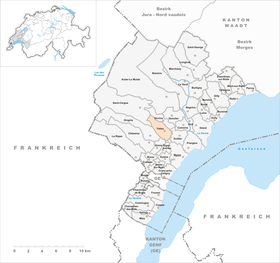Trélex
| Trélex | |
|---|---|
| State : |
|
| Canton : |
|
| District : | Nyon |
| BFS no. : | 5730 |
| Postal code : | 1270 |
| UN / LOCODE : | CH TRX |
| Coordinates : | 505 132 / 141155 |
| Height : | 508 m above sea level M. |
| Height range : | 462–764 m above sea level M. |
| Area : | 5.77 km² |
| Residents: | 1401 (December 31, 2018) |
| Population density : | 243 inhabitants per km² |
| Website: | www.trelex.ch |
| Location of the municipality | |
Trélex is a municipality in the Nyon district in the canton of Vaud in Switzerland .
coat of arms
The Trélex coat of arms shows a golden winnowing basket (with which the threshed grain is thrown into the air to separate the wheat from the chaff) on a red background.
geography
Trélex is located at 508 m above sea level. M. , 4.5 km north of the district capital Nyon (linear distance). The village extends at the southern foot of the Jura , on a slope slightly sloping to the south-east, in a panoramic position around 130 m above lake level of Lake Geneva .
The area of the 5.7 km² municipal area includes a section at the southern foot of the Jura. The municipal soil extends from the plain at the foot of the Jura to the northwest over the slope of Trélex to the forest area Bois de Trélex on the eastern slope of La Dôle . Here is at 760 m above sea level. M. reached the highest point of the municipality. The western boundary usually forms the main road from Nyon to Saint-Cergue, the eastern boundary runs in the valley of the Colline . In 1997, 14% of the municipal area was accounted for by settlements, 33% for forests and woodlands and 53% for agriculture.
Extensive single-family houses belong to Trélex. Neighboring municipalities to Trélex are Nyon, Duillier , Givrins , Saint-Cergue , Gingins and Grens .
population
With 1401 inhabitants (as of December 31, 2018) Trélex is one of the medium-sized municipalities in the canton of Vaud. 80.0% of the residents are French-speaking, 8.6% German-speaking and 8.4% English-speaking (as of 2000). The population of Trélex was 305 in 1900. After 1960 (301 inhabitants) a rapid increase in population began with a four-fold increase in the number of inhabitants within 40 years.
economy
Until the middle of the 20th century, Trélex was mainly an agricultural village. Below the village there are two small wine-growing areas (mainly the Chasselas , in German Gutedel ), otherwise agriculture is concentrated on arable farming thanks to the fertile soils . Further jobs are available in local trade and in the service sector. In the last few decades the village has developed into a residential community thanks to its attractive location. Many workers are commuters who work mainly in Nyon and Geneva .
traffic
Although the community is located away from major thoroughfares, it is still well developed in terms of traffic. The Nyon motorway junction on the A1 (Geneva-Lausanne) is only around 3 km from the town. On July 12, 1916, the Nyon – Saint-Cergue railway line (affectionately known by the locals as “le petit train rouge”, “the little red train”) with a station in Trélex went into operation.
history
Archaeological excavations have shown that a Roman villa already existed in antiquity in what is now the municipality. On the northern edge of the village you can still see the remains of a Roman fortification wall. The first written mention of the place took place in 1145 under the name Trailai , in 1296 the name Trelai appeared (which means something like "beyond the forest"). During the Middle Ages Trélex belonged to the Gingins rule, the village church was under the Cistercian Abbey of Bonmont . With the conquest of Vaud by Bern in 1536, the village came under the administration of the Nyon Bailiwick. After the collapse of the Ancien Régime , Trélex belonged to the canton of Léman from 1798 to 1803 during the Helvetic Republic, which then became part of the canton of Vaud when the mediation constitution came into force . In 1798 it was assigned to the Nyon district.
Trélex was particularly important until the end of the 19th century because it was the last post office before the Jura pass Col de la Givrine (near Saint-Cergue) on the road from Nyon to Paris (which already existed in antiquity). In Trélex, additional horses had to be harnessed to the stagecoaches in order to manage the steep ascent. This route was very popular and even Johann Wolfgang von Goethe , as he wrote in his “Letters from Switzerland” on October 27, 1779, passed the village on this way from Saint-Cergue to Nyon and is probably the most prominent visitor from Trélex.
Attractions
The reformed parish church of Trélex is located a little outside the village. In the old town center, some farmhouses from the 17th to 19th centuries have been preserved. There is a bell tower on the village square. The village restaurant (Auberge Communale), the former post office, is known throughout the region for its good cuisine. In the north of the village is the old post road to Paris, on which you can still hike to Saint-Cergue.
Personalities
- Gianni Infantino (* 1970), football official
- Gaël Monfils (* 1986), tennis player
Web links
- Website of the municipality of Trélex (French)
- Germain Hausmann: Trélex. In: Historical Lexicon of Switzerland .
- Aerial photography
Individual evidence
- ↑ Permanent and non-permanent resident population by year, canton, district, municipality, population type and gender (permanent resident population). In: bfs. admin.ch . Federal Statistical Office (FSO), August 31, 2019, accessed on December 22, 2019 .


